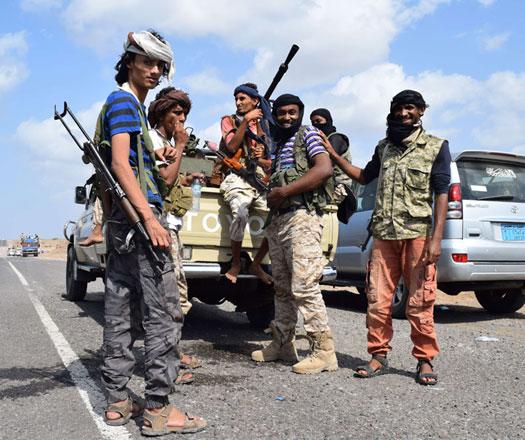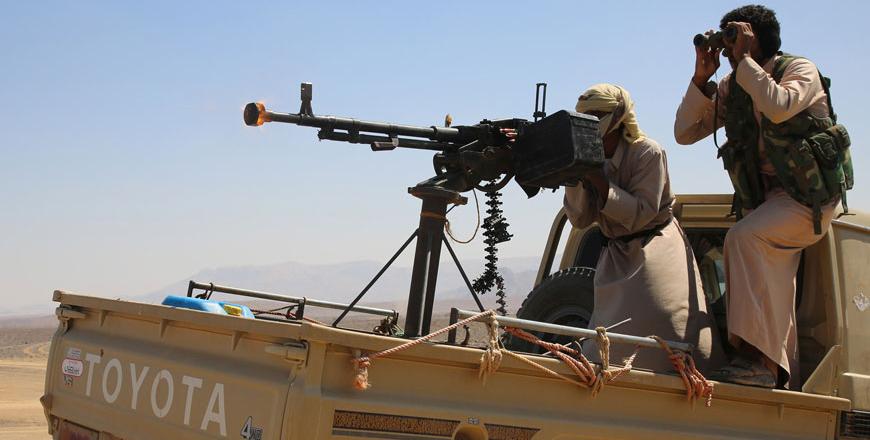You are here
Yemeni gov’t and Saudi-led forces retake Red Sea strait — spokesman
By Reuters - Oct 02,2015 - Last updated at Oct 02,2015

Fighters loyal to Yemeni President Abed Rabbo Mansour Hadi pose for a photo as they take a break en route from Aden to the strategic Bab Al Mandab Strait, in the southern Yemeni province of Taez, to re-enforce their comrades battling on the front line against Shiite Houthi rebels on Thursday (AFP photo)
DUBAI — Loyalist Yemeni troops and Gulf Arab forces on Thursday seized control of the Arabian side of the strategic Bab Al Mandab Strait connecting the Red Sea to the Gulf of Aden from Houthi fighters, a spokesman for the Gulf-backed government said.
Residents reported air strikes and shelling by warships in support of a ground push, but could not immediately confirm that the eastern shore of the strait had fallen.
"In a large-scale military operation launched today, Yemeni government, resistance and coalition forces liberated the Bab Al Mandab Strait and Mayun Island with the goal of safeguarding this key sea route," Rajeh Badi told Reuters by telephone from the southern port city of Aden,
170 km to the east.
Six months of war in Yemen has raised fears for the security of oil supplies through the strait, a main thoroughfare for vessels heading for the United States or Europe from Asia or the Gulf. Its western shore is controlled by Djibouti and Eritrea.
In 2013, more than 3.4 million barrels of oil per day passed through the 20km wide strait, according to the US Energy Information Administration.
A Houthi spokesman said the Saudi-led coalition and its allies had provoked a battle at Bab Al Mandab in a "blatant escalation" of the war.
"[The attack] aims to arouse concern in the international community over the safety of the shipping lane," a spokesman for the media office of Houthi leader Abdel-Malek Badruddin Al Houthi said on Facebook.
The coalition intervened in the civil war in March to try to restore the government after it was forced into exile by the Iranian-allied Houthis, and contain what Gulf Arab states see as Iran’s growing influence in their backyard.
Key bridge destroyed
The Houthi movement denies receiving any support from Iran and has described its seizure of large parts of Yemen, including the capital Sanaa, as a nationwide revolution against corrupt officials in the thrall of the West.
Ground fighting and coalition air strikes have killed more than 5,400 people, according to the United Nations.
The coalition, which includes Qatar, Bahrain and the United Arab Emirates, ousted the Houthis from Aden in July and has made some advances in the oil-producing Marib province, east of Sanaa. More than 150 coalition troops have been killed since March, but the Gulf-backed Yemeni government has returned to Aden.
The UAE said on Thursday that one of its soldiers had died from wounds sustained in Yemen in August, and Saudi Arabia said a border guard had been killed in Jazan province when his patrol was fired on from inside Yemen.
In western Yemen, residents said coalition air strikes had destroyed a bridge on the main road linking Sanaa and Hodeidah, effectively cutting the capital off from Yemen’s main port, on the Red Sea.
Pro-coalition Yemeni media said the destruction of the Aqd Asfara bridge, some 20km west of Sanaa, was part of the Gulf Arab alliance’s efforts to cut supply routes to the Houthis ahead of a ground advance on the capital.
However, the move is also likely to aggravate a humanitarian crisis already afflicting most of the country.
Related Articles
ADEN — Iran-backed rebels retook positions in southern Yemen in a bid to advance on second city Aden, military sources said Sunday as a land
RIYADH — Houthi rebels in Yemen are posing a threat to shipping in the strategic Bab Al Mandab Strait, the Saudi-led coalition supporting th
RIYADH — Saudi Arabia said Saturday that it was resuming oil shipments through the Bab Al Mandab Strait, ending a 10-day suspension triggere
















